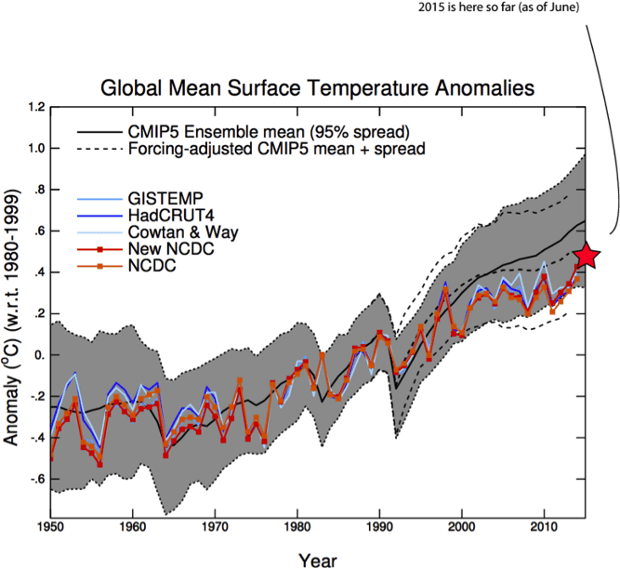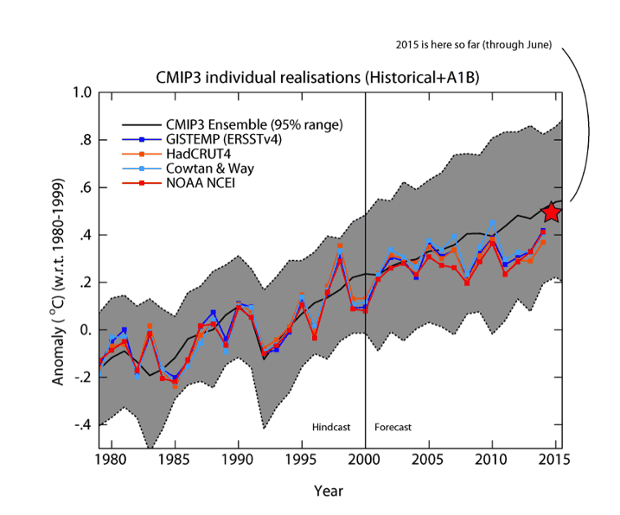2015 global temperatures are right in line with climate model predictions
Posted on 12 August 2015 by John Abraham
In an earlier post, I wrote about some research that compared ocean temperature measurements to climate model predictions. It turns out, the models have done a great job estimating the increase in ocean heat although they have slightly under-predicted the change.
What about other components of the Earth’s climate? For instance, how have the models done at predicting the changes in air temperatures? With recent data now available, we can make an assessment. I communicated with NASA GISS director Dr. Gavin Schmidt, who provided the following data.
The graph shows the latest computer model simulations (from the CMIP project), which were used as input to the IPCC, along with five different temperature datasets. The comparison to be made is of the heavy dashed line (annotated in the graph just below the solid black line) and the colored lines. The heavy dashed line is the average predicted temperature including updated influences from a decrease in solar energy, human emitted heat-reflecting particles, and volcanic effects.
The dashed line is slightly above the colored markers in recent years, but the results are quite close. Furthermore, this year’s temperature to date is running hotter than 2014. To date, 2015 is almost exactly at the predicted mean value from the models. Importantly, the measured temperatures are well within the spread of the model predictions.

Comparison of the most recent climate model simulations with actual global surface temperature measurements. Created by Gavin Schmidt.
If we next consider earlier predictions using the prior generation of climate models, we see results below. Again, we see that in recent years, temperatures are slightly below the average of the models, but well within the uncertainty range. Furthermore, if we were to add the current 2015 temperatures, it would be very nearly at the model mean.

Comparison of CMIP3 climate model simulations with actual global surface temperature measurements. Created by Gavin Schmidt.
So we see the models are doing a pretty good job. Certainly, they are good enough for us to project out into the future. I think of models as a crystal ball. We use them to see the future, albeit as a cloudy picture. While we cannot expect models to be perfect, they are good enough to help inform our decisions today.































 Arguments
Arguments






























Sorry, I hit "Submit" too early. Please delete my earlier post.
I've noticed some of our 'priuschat', climate deniers really enjoy claiming 'the models are wrong'. Showing that the models and data sources are being fixed seems to confuse 'em.
Lately, they've also been beating the 'paleo-record' drum. So it turns out the "Law Dome" ice record has CO{2} data that overlaps Maua Loa and that seems to have confounded them too. We used a log time-scale to show everything. The 'paleo' deniers are using a linear time-scale which hides the recent data . . . as if it doesn't matter.
Just sharing tricks of the trade.
Bob Wilson, Huntsville, AL
[RH] Please try to keep image down to 500px.
I came to the same conclusion with the same graphs:
https://ourchangingclimate.wordpress.com/2015/08/07/warm-2015-and-model-data-comparisons/In that post I also added a comparison of global temperatures with a few ‘sceptic forecasts’ from "Die Kalte Sonne", Scafetta and Easterbrook.
Dutch version here:
https://klimaatverandering.wordpress.com/2015/07/18/een-warm-2015-en-modelvergelijkingenprognoses/
Regards,
Jos
[PS] Fixed links. Please use the link button in the comment editor in future.
Thanks Jos for showing the "sceptic" forecasts which have shown to be so far off the mark. It would be helpful to keep track of them all. All these "global cooling" predictions are just fantasy.
Like Jos, a couple of years ago I put together some unusual and "couldn't be more wrong" alarmist predictions from deniers:
http://blog.hotwhopper.com/2013/07/denier-weirdness-collection-of-alarmist.html
While within the model envelope, I think that in a strong El Nino year, the surface temperature would be expected to rise above the line. As I understand it, the reason it doesn't is because the forcing estimates were on the low side (eg volcanic aerosols), as well as the PDO being in its cold phase till recently. The next few years will tell more of the story.
Sou, dont forget our friend John Kehr, aka TheInconvenientSkeptic, probably ASOFAI-fan, who thinks Milankovitch forcings somehow beat all other numbers.